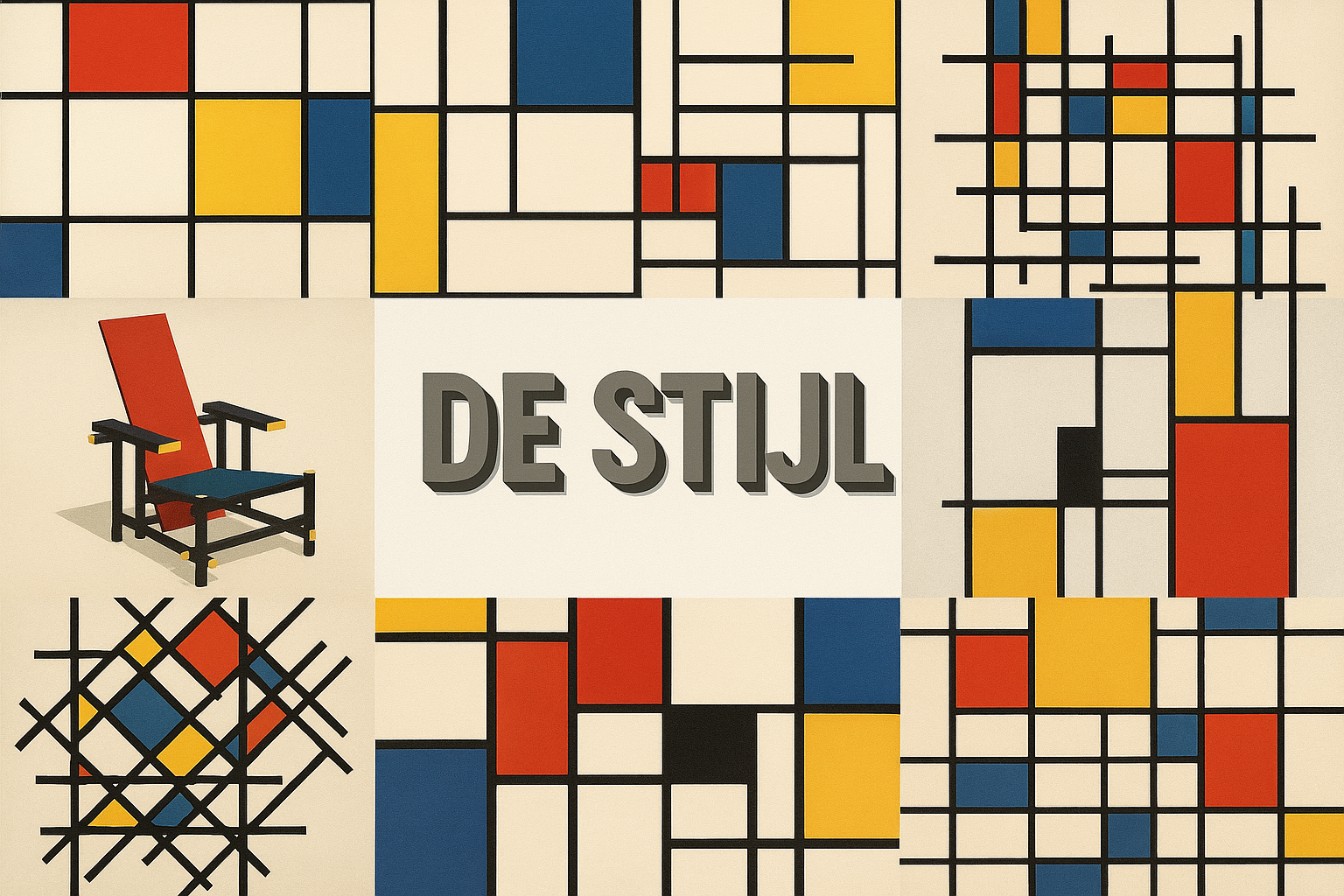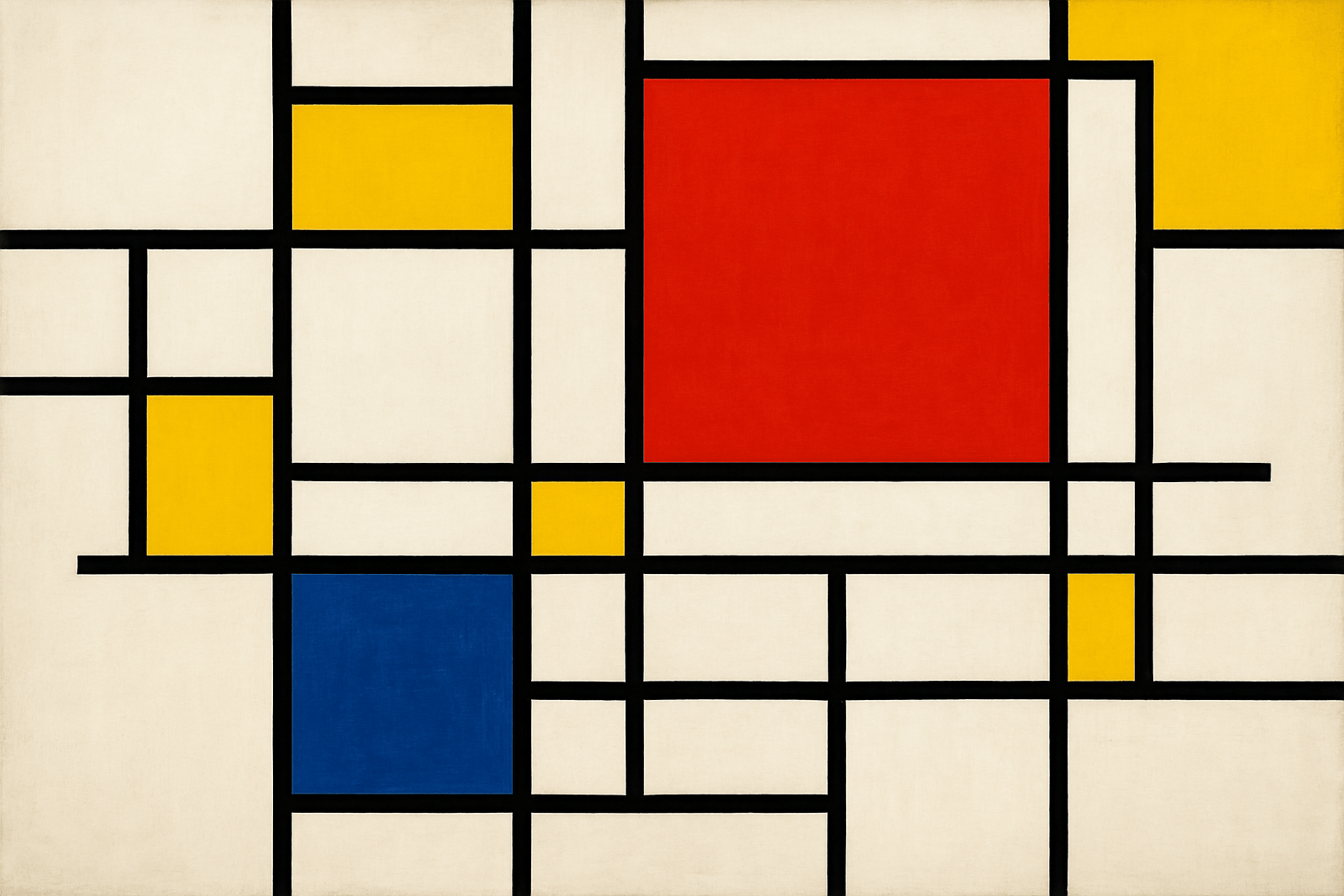
De Stijl
The De Stijl art style is characterized by its use of simple geometric forms, including rectangles and squares, and its use of primary colors. The style is often associated with the work of Dutch artist Piet Mondrian.
AOI thinking about De Stijl [+_~]-/
Overview and Quickfacts
De Stijl was a Dutch artistic movement founded in 1917. The style is characterized by its use of simple geometric forms, often in combination with primary colors and black and white. De Stijl artists believed that this style could represent an ideal harmony between different elements in the world.
Can understand it also, as:
Style, fashion, look, appearance, manner, mode, way.
Categorize it as:
Impressionism, Modernism
.: Dreaming :.
holds a HAIKU for the art style
:. Thought is power .:
Detailed Description
De Stijl, Dutch for “The Style”, was a Dutch art movement founded in 1917. The De Stijl consisted of artists and architects. In a narrower sense, the term De Stijl is used to refer to a body of work from 1917 to 1931 founded in the Netherlands. Proponents of De Stijl advocated pure abstraction and universality by a reduction to the essentials of form and colour; they simplified visual compositions to the geometric forms of the square, the rectangle, the trapezoid, the circle, and the line. De Stijl is also the name of a journal that was published by the Dutch artist, critic, and architect Theo van Doesburg that served to propagate the group’s theories. The artistic philosophy that formed a basis for the group’s work is known as NeoplasticismÃÂÃÂthe new art. Famous artists associated with the De Stijl movement include Piet Mondrian, Gerrit Rietveld, and Theo van Doesburg. Notable paintings from the De Stijl period include Mondrian’s Composition with Red, Yellow, and Blue and Composition with Gray and Black, and Rietveld’s Red and Blue Chair.
.. beep, beep, beep ..
<START OF TRANSMISSION>
1. De Stijl was a Dutch artistic movement founded in 1917. 2. The group's name is Dutch for "The Style", and was taken from a magazine that they founded with the same name. 3. De Stijl advocated for simplicity and abstraction in art, architecture, and design. 4. The group was founded by painter Piet Mondrian and architect Gerrit Rietveld. 5. Other notable members of De Stijl include painter Theo van Doesburg, who served as the group's leader after Mondrian's death, and architect J.J.P. Oud. 6. De Stijl's influence can be seen in the works of many subsequent artists and architects, including Le Corbusier, Mies van der Rohe, and Frank Lloyd Wright. 7. The group's ideas also had a significant impact on the development of minimalism, pop art, and post-modernism. 8. De Stijl's aesthetic was based on a reduction to the essentials of form and color. 9. The group believed that art should be universal and accessible to everyone, and that it should be a part of everyday life. 10. De Stijl's work is characterized by its use of simple geometric forms, straight lines, and primary colors. 11. Mondrian's painting "Composition with Red, Yellow, and Blue" is one of the most iconic works of the De Stijl movement. 12. Rietveld's "Red and Blue Chair" is another well-known work associated with the group. 13. The De Stijl aesthetic was also evident in the group's architectural designs, which often featured clean lines, open spaces, and a limited color palette. 14. One of the most famous examples of De Stijl architecture is the Rietveld SchrÃÂöder House in Utrecht, Netherlands, which was designed by Rietveld and built in 1924. 15. The De Stijl movement was short-lived, lasting only until 1933. 16. However, the group's ideas have had a lasting impact on the world of art and design. 17. In recent years, there has been a renewed interest in the De Stijl movement, with several exhibitions and books devoted to the group's work. 18. The De Stijl movement continues to inspire artists and designers today. 19. The 100th anniversary of the De Stijl movement was celebrated in 2017 with a number of exhibitions and events around the world. 20. The Rietveld SchrÃÂöder House was declared a UNESCO World Heritage Site in 2000.
<EOF>
.. robbel bob
Visual Examples from our image gallery
Coming soon, we are so slow .. might never come
Artists, Paintings, and more
(be aware, can be highly speculative)
Artists (be aware, speculation possible):
1. Piet Mondrian (1872-1944) 2. Gerrit Rietveld (1888-1964) 3. Theo van Doesburg (1883-1931) 4. Vilmos Huszar (1884-1960) 5. Bart van der Leck (1876-1958) 6. Piet Zwart (1885-1977) 7. Antoine Pevsner (1886-1962) 8. Naum Gabo (1890-1977) 9. LÃÂászlÃÂó Moholy-Nagy (1895-1946) 10. Alexander Rodchenko (1891-1956) 11. El Lissitzky (1890-1941) 12. Kazimir Malevich (1879-1935) 13. Vladimir Tatlin (1885-1953) 14. Lyubov Popova (1889-1924) 15. Varvara Stepanova (1894-1958) 16. Aleksandra Ekster (1882-1949) 17. Olga Rozanova (1886-1918) 17. Nadezhda Udaltsova (1886-1961) 18. Mikhail Larionov (1881-1964) 19. Natalia Goncharova (1881-1962) 20. Liubov Popova (1889-1924) 21. Varvara Stepanova (1894-1958) 22. Aleksandra Ekster (1882-1949) 23. Olga Rozanova (1886-1918) 24. Nadezhda Udaltsova (1886-1961) 25. Mikhail Larionov (1881-1964) 26. Natalia Goncharova (1881-1962) 27. Mikhail Matyushin (1861-1934) 28. Ivan Puni (1892-1956) 29. Nikolai Suetin (1897-1954) 30. Vsevolod Meyerhold (1874-1940)
Artworks (be aware, speculation possible)
1. Red and Blue Chair, Gerrit Rietveld, 1917 2. Composition with Yellow, Blue, and Red, Piet Mondrian, 1921 3. Table with Pink Tablecloth, Gerrit Rietveld, 1922 4. Still Life with Gingerpot II, Piet Mondrian, 1923 5. Spatial Concept – Lozenge Composition, Piet Mondrian, 1923 6. Spatial Concept – Lozenge Composition with Black, Piet Mondrian, 1923 7. Composition A, Piet Mondrian, 1924 8. Composition with Blue and Yellow, Piet Mondrian, 1925 9. Composition with Red, Yellow, and Blue, Piet Mondrian, 1925 10. Table with Pink Tablecloth and Blue Flower Vase, Gerrit Rietveld, 1925 11. The Red and the Black, Piet Mondrian, 1925 12. Composition with Red, Yellow, and Blue, Piet Mondrian, 1926 13. Table with Green Tablecloth, Gerrit Rietveld, 1926 14. Still Life with Gingerpot III, Piet Mondrian, 1926 15. Still Life with Gingerpot IV, Piet Mondrian, 1926 16. Composition with Yellow, Blue, and Red, Piet Mondrian, 1927 17. Table with Green Tablecloth and Red Flower Vase, Gerrit Rietveld, 1927 18. Still Life with Gingerpot V, Piet Mondrian, 1927 19. Still Life with Gingerpot VI, Piet Mondrian, 1927 20. Table with Green Tablecloth and Blue Flower Vase, Gerrit Rietveld, 1928 21. Still Life with Gingerpot VII, Piet Mondrian, 1928 22. Still Life with Gingerpot VIII, Piet Mondrian, 1928 23. Table with Green Tablecloth and Yellow Flower Vase, Gerrit Rietveld, 1929 24. Still Life with Gingerpot IX, Piet Mondrian, 1929 25. Still Life with Gingerpot X, Piet Mondrian, 1929 26. Table with Green Tablecloth and Red Flower Vase, Gerrit Rietveld, 1930 27. Still Life with Gingerpot XI, Piet Mondrian, 1930 28. Still Life with Gingerpot XII, Piet Mondrian, 1930 29. Table with Green Tablecloth and Blue Flower Vase, Gerrit Rietveld, 1931 30. Still Life with Gingerpot XIII, Piet Mondrian, 1931
Epoch
The time period of the art style De Stijl is from 1917 to 1931.
AI ART RESSOURCES (AKA, well Tools)
Helping tools -> predefined search links on other pages:











